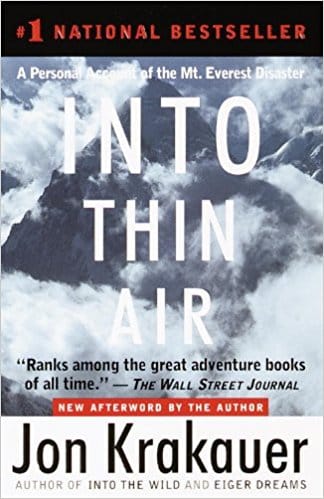I was about to try my hand at mountain climbing for the first time (at the very modest height of 6500m) when I stumbled across the movie Everest on Netflix. After watching it and becoming terrified, I felt I wanted to read the true story behind the 1996 disaster that took place on Mt. Everest. While the movie was based around several books written by survivors, it’s journalist Jon Krakauer’s book, Into Thin Air, which seems to be the most factual.

Jon Krakauer was on assignment as a journalist during the notorious 1996 Everest disaster. He had been hired by a magazine to write an article about the effects of commercialism on the Everest Region. The book is full of amazing facts about Nepal and Mt. Everest in general. For instance, people couldn’t visit Nepal prior to 1949, which I find fascinating. Having been to Everest Base Camp in October, I learned a lot about different expeditions, the Sherpa culture, and Nepal.
I could relate to the feelings one goes through at altitude. I’d find them hard to describe, but Into Thin Air does a great job of painting a vivid picture of the everyday struggles one has to endure while at altitude. You get to read about each member of the team’s problems including not being able to breathe or think, snow blindness, horrible coughs, etc. along with the fatigue that comes from taking a single step with limited oxygen.
“The longer I climb the less important the goal seems to me, the more indifferent I become to myself”
The real story though is what happened on one fateful day when several expeditions went to summit the tallest mountain in the world, and only a few returned. There has been much speculation about the event and how it unfolded. This book looks at the incident from as many angles as possible, only missing the stories of those who didn’t survive to tell the tale.
Most of the book revolves around one company, Adventure Consultants, who became famous for getting mediocre mountain climbers to the top of the world. They paved the way for guided expeditions up Everest, and in turn received a lot of criticism. Another guided expedition team, Mountain Madness, began to compete with Adventure Consultants creating a rivalry. Both teams set out for the summit on the same day, and both found it imperative to get their clients to the top.
“Unfortunately, the sort of individual who is programmed to ignore personal distress and keep pushing for the top is frequently programmed to disregard signs of grave and imminent danger as well… Above 26,000 feet, moreover, the line between appropriate zeal and reckless summit fever becomes grievously thin. Thus the slopes of Everest are littered with corpses.”
Amidst some poor decision making and a brutal storm, not everyone made it back down alive. Those who did survive were scarred mentally and physically, having had to make tough decisions on who was worth saving and who would be left behind to die. Jon Krakauer, a skilled mountain climber, made it back to camp in time. He fell asleep due to extreme exhaustion and believed his team was behind him, while 350m away several people were freezing to death, unable to locate camp.
My only complaint about this book is that it seems Jon Krakauer had received much criticism after his article was published, so he felt he had to defend his actions on the mountain that day. As an aspiring writer, it was upsetting to read through the lines and hear his struggle. Having only been to an altitude of 5800m, I can tell you that your brain does not function normally. I can’t even imagine making life or death decisions at 8000m which is commonly referred to as “the death zone.”
Overall, the book is an incredible true story of man’s motivation to accomplish the impossible, and how ego can drive us to do things that maybe we weren’t meant to. It shows a small glimpse into the world of mountain climbing and the camaraderie and competition that goes along with it. Most of all, it’s an action packed story of the lengths one will go to for survival, and what happens when humans are put in extreme conditions. It’s both heartbreaking and inspiring, and a must read for anyone coming to Nepal.
You might also like…

Michelle Della Giovanna
Writer at Full Time Explorer
I’m just your average New Yorker who quit her job in the fashion industry to explore the world. Come find out what it’s like to trade in five-inch heels for squat toilets.




Leave a Reply